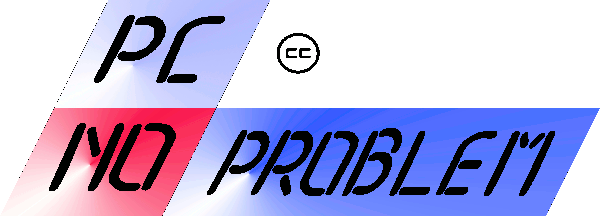
OPERATIVE SYSTEMS
The operating system of a machine is a series of software instructions, which have the purpose of activating the hardware structure, making it work and providing a graphical or command line interface, understandable to the human user.
One could say that it has the function of interpreter between human language and machine language.
Generally, if you know what an operating system is, your mind immediately goes to the only examples that the general user knows: MacOs and Windows, as widely used commercial products, but there are many existing operating systems, generally almost all much more refined, safer, faster and more powerful than the two systems just mentioned.
One of the safest things in the landscape of existing operating systems is that the Windows system is probably the worst system in the world, and also one of the most popular.
Many are also open source, therefore constantly evolving, but non-commercial and therefore not advertised, and consequently little known. Among all Linux, one of the best operating systems ever.
In this section some solutions are presented, generally of free distribution, open or freeware, some are decommissioned systems, others in an embryonic stage, others very structured and stable, all the kind of not simple installation for those who are not experts, and sometimes even for those who are experts they are of complex configuration, for which we understand their not widespread diffusion, and for which we understand the growing diffusion of Linux, which instead becomes more and more easy to install, configure and use.
Let's see a small roundup of operating systems, many have been personally tested and evaluated by me. Almost all of them work on very common machines, such as those found in every home or office. In some rare cases I have used virtual machines, but if the operating system is tested on a real computer, apart from the various technical difficulties, the speed and satisfaction are unmatched, much greater.
In many cases, an ISO file is downloaded from the site, which must be burned onto a CD in a particular way or a boot stick is created.
FREEDOS
FREEBSD
OpenQNX
BEOS5
HAIKU
AROS
REACTOS
BASILISK
MENUET
JNODE
KOLIBRI
SYLLABLE
OBERON
FREEDOS 1.0 https://www.freedos.org/

Interesting clone of the old and glorious DOS. Active project.
Extended and expanded in a remarkable and surprising way, project alive receives the contribution of many programmers. It is supplied as an ISO image to download, it is possible to have the set of floppies or a CD, the full version includes hundreds of software, drivers and applications for DOS and FREEDOS, including a graphical interface to manage with the mouse called GEM and a interesting graphical browser called ARACHNE, rather refined that allows navigation also of the local computer, is able to capture the screen in an Arachne TGA image. Allows different command bar solutions.
The CD is in the LIVE version so it is possible to test FREEDOS without installing it, but it is also possible to use the internal installation program. Having a DOS Live is a remarkable thing!!!
The installation is very long but fully guided, the system, like the installation, is multilingual, the interface is textual but navigable with the arrow keys.
All the DOS commands are perfectly replicated and in many cases even improved, in addition there are derivations from UNIX and very useful integrated behaviors (such as the automatic memory of the typed commands, the old DOSKEY for those who know it). Many Unix commands work, such as "ls".
Among the applications stand out utilities for managing and accessing MAC and LINUX EXT2 disks, which was not even imaginable in DOS.
Equipped with programs for managing images, for creating and video CDs, for sound, for archives, text editors, programs for networking, for internet browsing, remarkable and powerful programs for development and programming, many games among which open source DOOM, when EVERYTHING is installed takes up over 400 MB of disk, which for being DOS is considerable.
The driver package is quite rich, which makes it quite elastic and adaptable. The project is in development and expansion, the thing is interesting, it is curious the fact that in an era in which all systems tend to push graphics there is this branch that develops text programs or with very reduced graphics ... certainly a managed PC with FreeDos it reaches frightening and fulminant speeds. The spartan interface is obviously not really suitable for everyday work and cannot be addressed to the general public, but rather to a trained user with a good amount of technical knowledge, however it remains an extremely interesting system, equipped with a good GUI can become very powerful.
Screenshots:
Monitor photos via camera and internal screenshots via tool included in Arachne. Disk save and recovery with Win98 over Samba network with Linux.
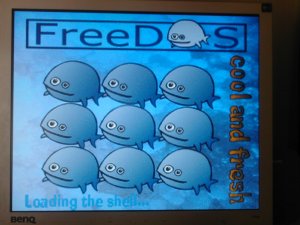 |
| The start splash |
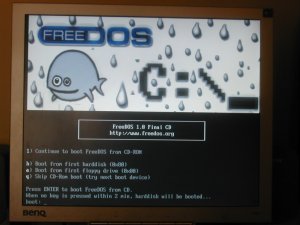 |
| System boot |
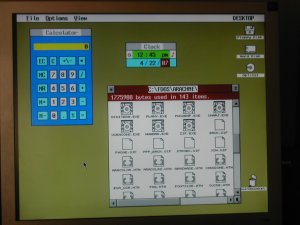 |
| GEM exploring Aracne |
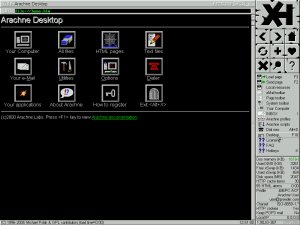 |
|
Aracne with its
Desktop manager
|
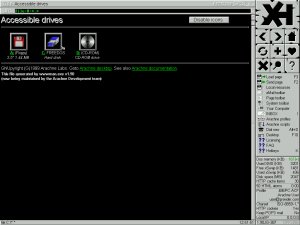 |
| Aracne displays the HD |
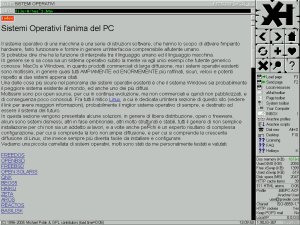 |
| Aracne sorfing on this page |
FREEBSD 6.2 https://www.freebsd.org/it/

Active and under development
Derived from UNIX it retains a decidedly X-like architecture. Multiuser and multisession, it is very stable, solid and reliable. Suitable for network work, it is an excellent way to build very robust network servers. Compatible with all Unix programs, it can be used with Linux-derived graphical daemons. There is the possibility to use it from a live disk, to evaluate it, or to install it directly on the hard disk.
In the tested version a Linux-derived XFCE GUI is used.
Like all UNIX systems, it recognizes the number of keys pressed or the number of fingertips resting on the pad of the laptop (if the system runs on a laptop), so the two keys or fingers change the desktop, while three fingers simulate the right key. Light and fast even from live disk. It recognizes a large number of partition formats without problems. Like all X systems its power lies entirely in the shell.
Screenshots:
Live CDs. Images taken via GIMP screen capture, command line mounting of a Linux EXT2FS disk and saving to it.
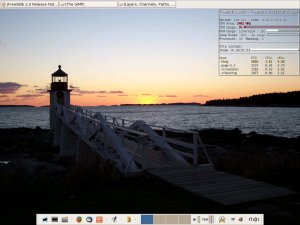 |
A desktop with a Mac like dock,
XFCE interface
|
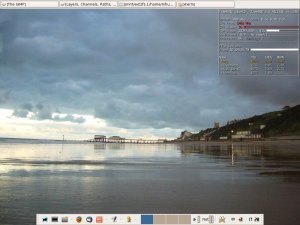 |
Another screen with
system resource in real time |
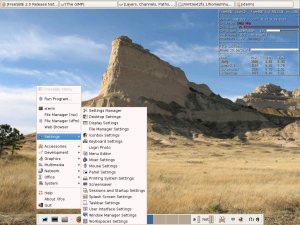 |
The right click displays
the start menu |
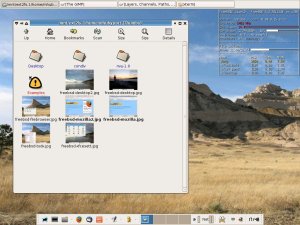 |
Browing a mounte drive
|
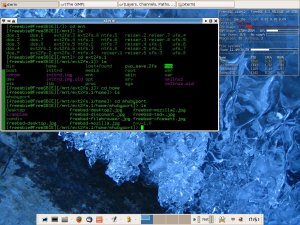 |
| The same drive in promtl |
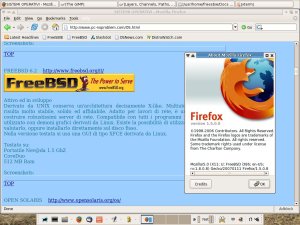 |
| Mozilla on this page |
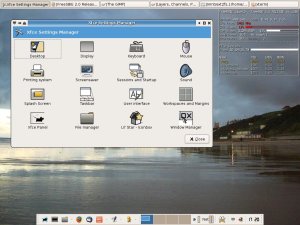 |
XFCE Control panel
|
OpenQNX 6.2.1 https://openqnx.com/
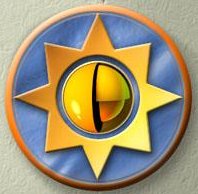
Active and slowly developing.
Based on UNIX technology, it has an interesting graphical interface that is easy to use and understand. It exists in LIVE ISO format and as an HD install. It recognizes a lot of HW very easily, but still has problems with USB technology. It automatically mounts any disks it finds on the host computer. Automatically configure the network and its connection. It is not currently very rich in applications, but it is under development, the software can be downloaded from the operating system site, there is also a system for downloading and installing packages from the network. The right-hand bar called SHELF is very practical and interesting, containing links to almost everything that can be done on the machine, organized in very comfortable retractable curtains. The system terminal is a typical UNIX terminal, where the main commands apply. The internal help, structured like HTML, is very articulated, well done and very technical, it is very useful in approaching this system.
Overall it is very interesting, unfortunately the development of the project does not proceed very quickly, however it has a good maturity that highlights it in the panorama of operating systems.
Screenshots:
The images were captured with an internal tool. Saving to proprietary disk and recovering via Win98 over Samba network.
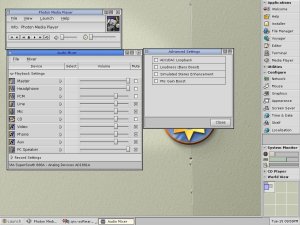 |
| The classic desktop |
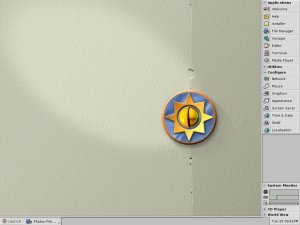 |
| A second desktop |
 |
| Multimedia system |
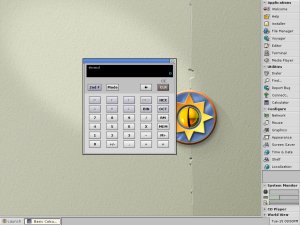 |
| The calculator |
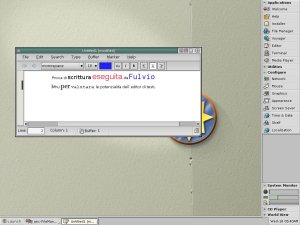 |
| A small text editor |
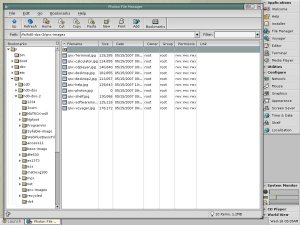 |
File manager on
W98 partition |
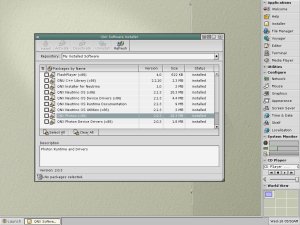 |
| Package manager |
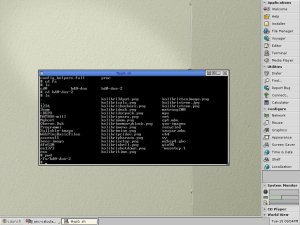 |
| Command shell Terminal |
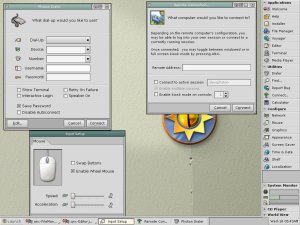 |
| Some system tools |
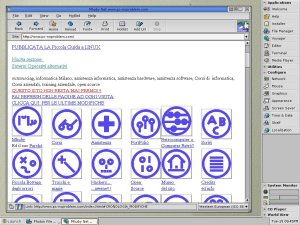 |
| Browsing on this page |
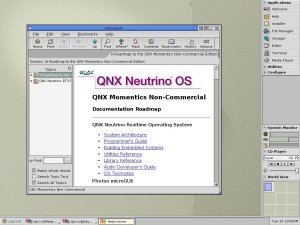 |
| Internal help |
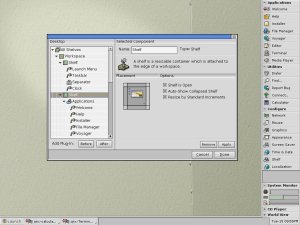 |
| SHELF configuration |
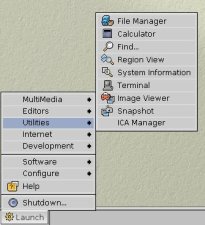 |
Launch menu is the same
of the Shelf |
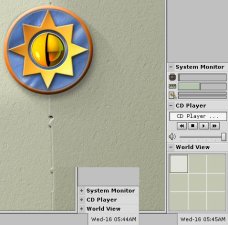 |
Lower SHELF:
9 desktops
|
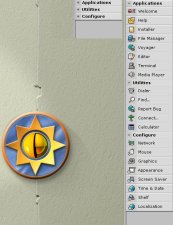 |
| Highpart of SHELF |
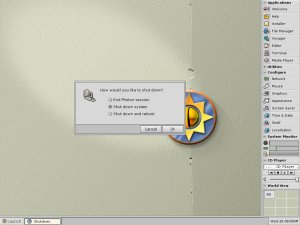 |
LogOut
|
BEOS 5
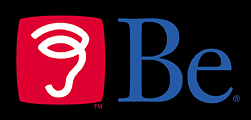
Project discontinued in 2001.
An incredible operating system and 10 years ahead of its peers. Commercial project of the 90s, contemporary of Windows 95/98, was able to do things unthinkable with a PC with X86 electronics of those times. Produced by BE Incorporated it was created from scratch, as an original and innovative idea, therefore it does not derive anything of itself from UNIX, it had various ups and downs and a lot of bad luck, after a start with Apple machines, it passed on X86 machines, Microsoft countered in every way the project (it was such a powerful and winning project that if it had taken hold among PC manufacturers today in the world they would not know Windows and there would be no stability and virus problems and computers would be at least 5 times faster than they are today!!! Microsoft realized this and made war against it, was sued and lost over 23 million dollars in 2003 but by now the damage was done and all possible commercial agreements lost...).
The installation is trivial and guided, quick and very simple, it recognizes, generally without problems, a large part of the HW of the computer that hosts it, without the need to install various drivers, capable of self-configuring various cards including a large quantity of network cards, however many drivers are available on the internet. Its modular structure is able to stop and restart the required service without restarting the whole system. It is also able to recognize mount and use in reading and writing, disks formatted with UNIX, LINUX, NTFS and MAC, which is remarkable, especially for the era in which it was born, perhaps it was the only system in the world to do all these things Together.
Equipped with a decent supply of programs, it is possible to find a lot of material on the net. It has an installation and download management system, in a certain sense similar to the SYNAPTIC system of many Linux distributions, a system born many years later.
The machine is very fast at work, the operating system being quite light.
The right button has immense power and with it you can do almost everything, very interesting is the way to explore disks and folders and copy - cut - move files, create links, among other things mount and unmount disks, all with just two clicks with the right button.
It manages 9 desktops by default, but comes up to 32 independent desktops in terms of settings and resolution.
There was a free version for personal use called BEOS PE (personal edition), which came as a 43 MB Windows installation file. The system does not require a dedicated disk and does not alter the boot structure in any way, it creates a 512 MB file on the disk and creates its world in it, then a boot floppy is created which, the next time the machine is restarted, access the 512 MB file and wake up the system frozen in it. If you download and install programs, everything fits into the 512MB virtual disk. In this way you can use BEOS 5 PE without damaging or touching the operating system on your PC at all. An ingenious and simple system for the dissemination of the project. The commercial version then provided for an actual installation.
Perhaps one of the most beautiful and fascinating systems I've ever had the pleasure of using.
Screenshots:
Teste on a real PC. Images captured with the PRINT key (Print Screen), saved on a local hard disk mounted with internal menu command. Linux network recovery.
A photo with a camera.
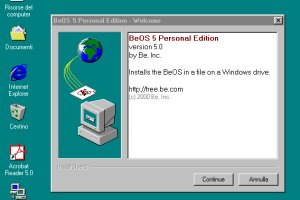 |
Windows 98 installation
|
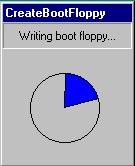 |
The Floppy boot creation
|
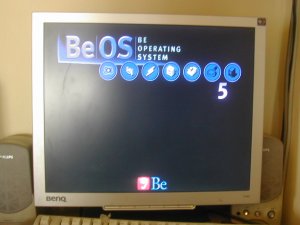 |
| The start screen |
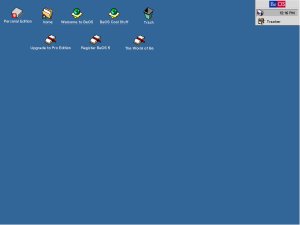 |
| The essential Desktop |
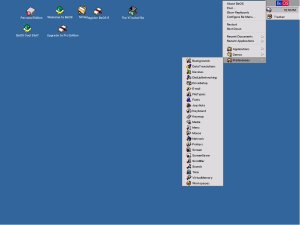 |
The start menu
over the logo are active tasks
|
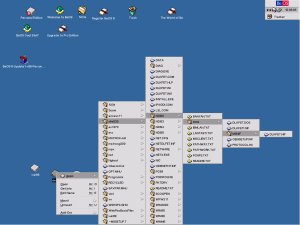 |
| File system navigation method |
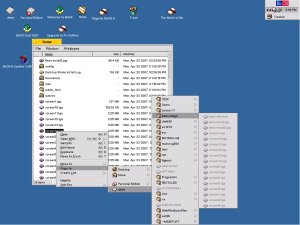 |
| Copy and paste method |
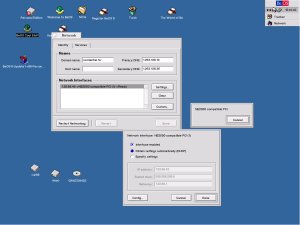 |
| Network adapter configuration |
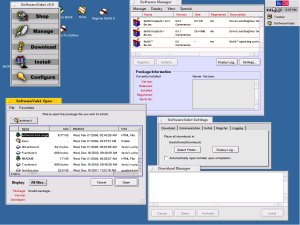 |
| Software Valet, managing apps. |
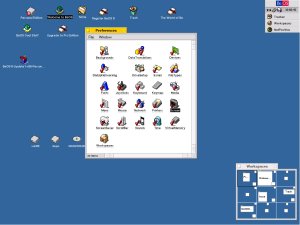 |
Virtual desktop manager up to 32
|
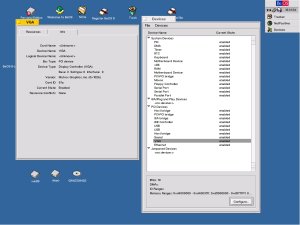 |
| System resources manager |
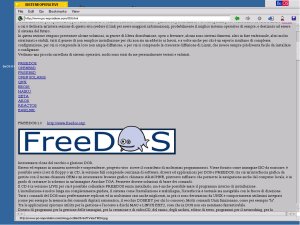 |
| Browsing this page |
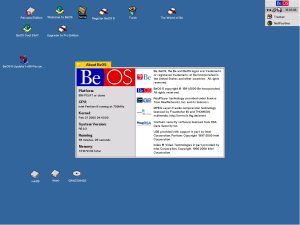 |
About BeOS
|
HAIKU https://www.haiku-os.org/

Active and rapidly developing.
Open source project, it aims to rebuild the BeOS operating system so that you can use all the existing software for BeOS without problems and hitches.
It is currently available in ISO installation CD format which allows you to use the system also in live. Currently in 2010 an alpha2 version is ready. Currently the structure achieved is very stable and completely identical to BeOS5, the compatibility with the pre-existing software is very high, the premises for being able to use the BeOS - HAIKU environment on a large scale are very high.
Tested on a real machine of minimal power (a Celeron 600 with 256 MB of RAM and mechanical disk, it is extremely fast and ready, it seems to work on a much more powerful machine) in 30' it boots.
Compatibility with various hardware is still not very extensive.
The pleasure of working on BeOS is perfectly reproduced.
Screenshots:
Images from Linux PrintScreen, cropped with GIMP.
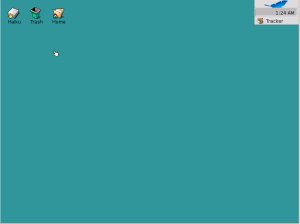 |
| The Desktop, very similar to BeOS |
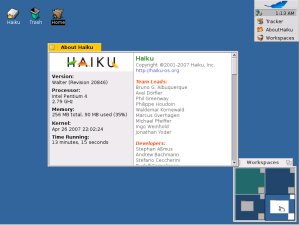 |
| About Haiku |
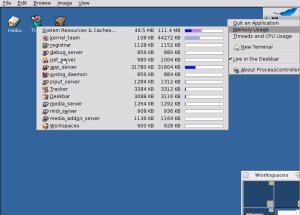 |
| Memory management |
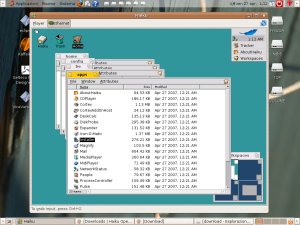 |
The VM on Linux
|
AROS 0.2.3 https://aros.sourceforge.io/it/
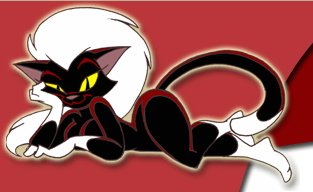
Project in stasis but has reached an interesting level of development. Currently the most complete and easy to use version is distributed as a program hosted inside a Linux window, you download it, unpack it and run it as is without installation. The system aims to replicate the AMIGA operating system, and to be compatible with all the software written for this environment. The graphic aspect is really very captivating and interesting. Rich in applications and demos to evaluate its power, it is worth keeping an eye on, the premises are remarkable.
Screenshots:
Images from Linux PrintScreen, cropped with GIMP.
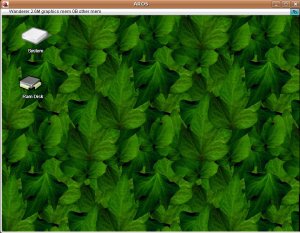 |
The desktop simple and clean
|
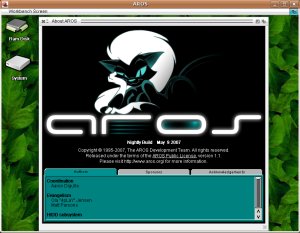 |
| About AROS... |
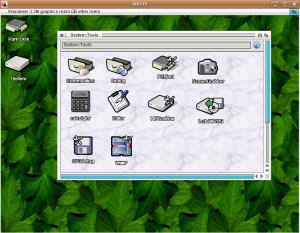 |
| System tools |
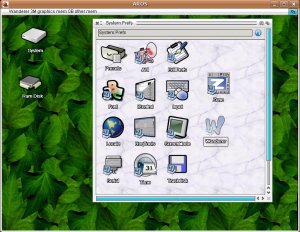 |
| System preferences |
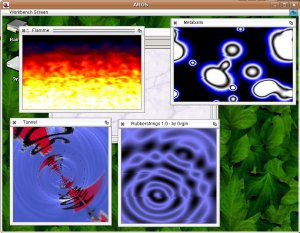 |
| Some graphical OpneGL demos |
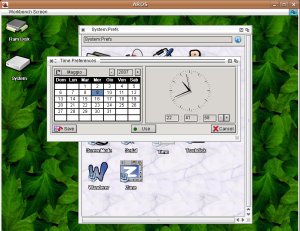 |
| Calendar end system clock |
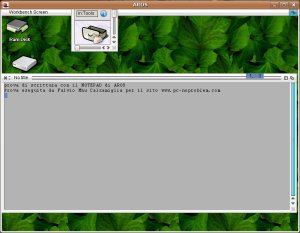 |
| The small text editor |
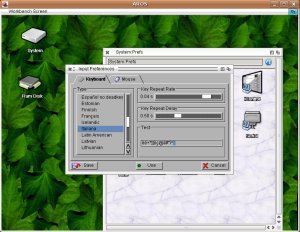 |
Keyboard manager
|
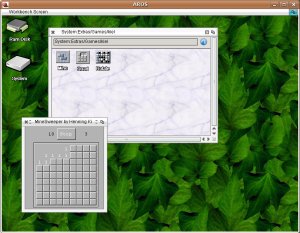 |
| Mines... |
REACTOS 0.4.14 https://reactos.org/index.html
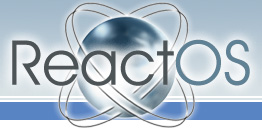
Very interesting active project, open source and under development.
Still in the alpha phase, it is proposed to build a perfect clone of Windows, so as to be able to use all the programs and all the drivers relating to the HW components that have been expressly built for Windows. Basically use the whole world created for Windows without using Windows...
Lots of features still haven't been implemented and it still has a lot of video card recognition problems, but the system starts up and runs and lots of software installs and runs without problems. It is a very powerful alternative to Windows without any hassle of having to search and repurchase the software that a user uses. When it reaches a more complete form it will be a system to be seriously considered. It exists in installer format and in Live CD format, both of which are provided as ISO files to create the CD. It is still rather unstable and not easy to manage, but it must be considered that it is still in the alpha phase. It features features taken from the Unix-Linux world, such as shell command memory and multiple desktop management. The system is capable of recognizing and configuring the network card by itself, in order to make it possible to automatically download and install Firefox, and then start searching and downloading the drivers for the other peripherals. Furthermore, there is an integrated program for downloading tested and functioning opensource programs from the REACTOS DOWNLOAD CENTER, a structure that recalls the SYNAPTIC system of some Linux distributions or the Linspire CNR on a small scale, which immediately facilitates the expansion of the system and a easier and more practical to use.
Screenshots:
The screenshots are from a QEMU virtual machine session running under Ubuntu 7.10
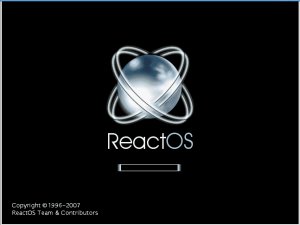 |
| The boot |
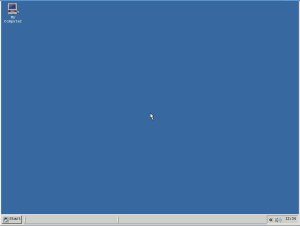 |
| The simple desktop |
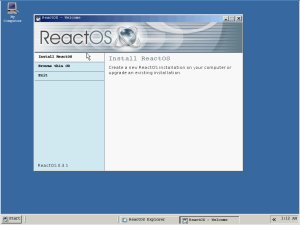 |
| Welcome window |
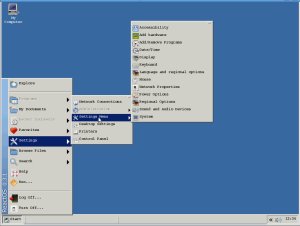 |
| Start menu |
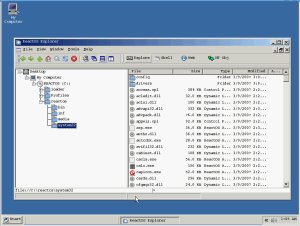 |
| Explorer, a way to browse files |
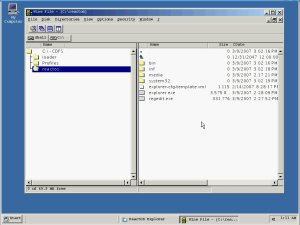 |
| WinFile, another way to browse files |
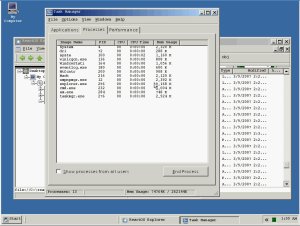 |
| Taskmanager |
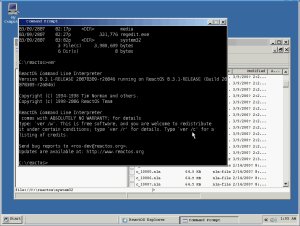 |
| DOS prompt |
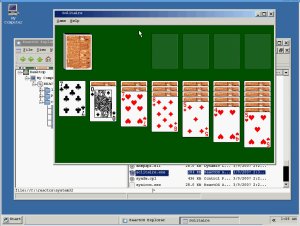 |
| Solitaire must never be missing!!! |
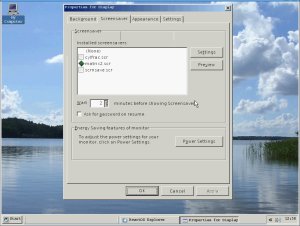 |
| Screen properties |
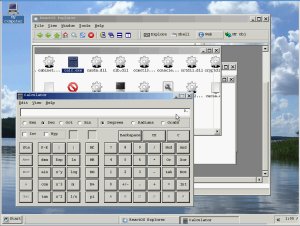 |
| Scientific calculator |
BASILISK II https://basilisk.cebix.net/
Mature, in stasis since 2001.
Curious and interesting project that aims to create a virtual environment for BeOS, Amiga, Windows and the UNIX world, including Linux, in which it is possible to install and run a 68K MacOS system.
To achieve everything you need to have the image of an original rom extracted by software from a real MAC, I personally used that of one of my collectible laptops. The operating system is instead available on the APPLE website, which has made the MacOS 7 version public and distributed free of charge. It is a complex and complete virtual environment capable of perfectly recreating a Mac machine.
The result is amazing and really interesting, you can use the CD to install Mac software inside the emulator, basically the Windows PC becomes a real old Mac!!!
Tested on:
Pentium 4 2.8Mhz
1GB RAM
ATI RADEON 256MB
Windows 2000
Screenshots:
Print Screen under Win 2000, saving to FAT32 disk, recovering and manipulating with GIMP under Linux.
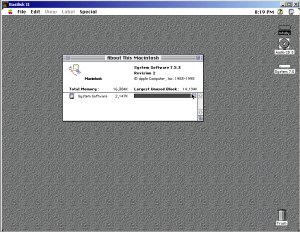 |
| The desktop with about |
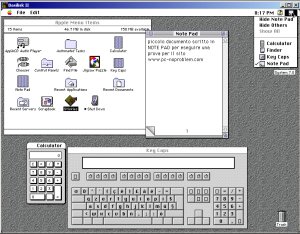 |
| Some applications |
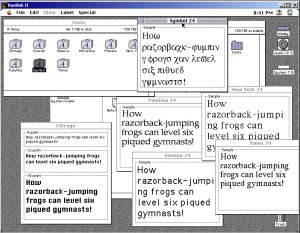 |
| Some system fonts |
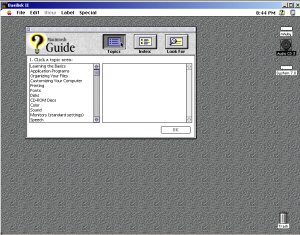 |
| The internal help |
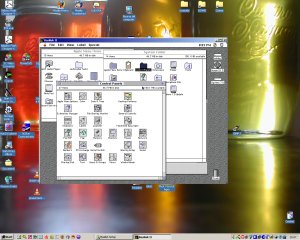 |
| The VM inside Windows |
MENUET 0.86B https://www.menuetos.net/

Active and under development.
Operating system under development for many years, has seen an impressive and incredible evolution, its target is to create a self-sufficient and complete operating system, with graphical interface and application programs, ALL ON A FLOPPY!!! The first time I tested this operating system was 2000, downloading the MINSTALL.EXE file for Windows creates a boot floppy that starts the system with Menuet 0.75 Beta, while the 0.82 version can be obtained from the site. The system uses ram to expand and work, surprisingly full of applications it seems impossible that everything you see can fit on a floppy. The first steps of the boot collect, with a text interface, information on the type of resolution, video card, mouse and RAM used, then you move on to the graphical interface.
The set of programs is remarkable, however they are generally technical software, others of a demonstrative type, certainly the potential is enormous.
It is unable to memorize the settings recorded at startup (type of resolution, mouse, etc.)
The CD ISO is present on the site with a much larger and more complete set of programs, and this would also solve the problem of the increasingly widespread tendency of manufacturers to remove the floppy from new machines.
Screenshots:
Photos of the real screen.
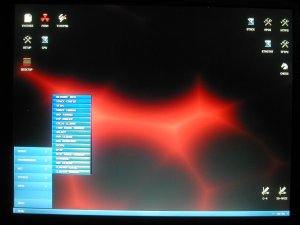 |
Menuet 0.75
Start menu |
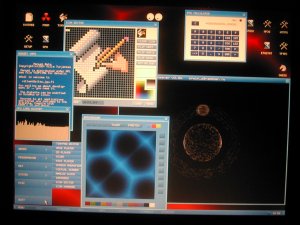 |
Some apps,
interesting the particle generator
|
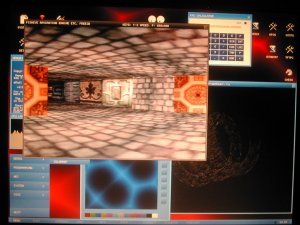 |
| 3D maze very fluid |
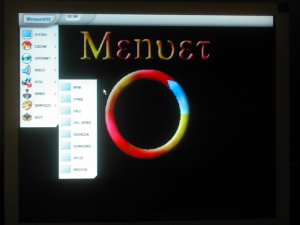 |
Menuet 0.82
Desktop |
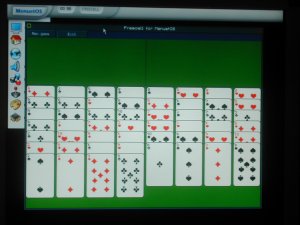 |
Menuet 0.82
FreeCell |
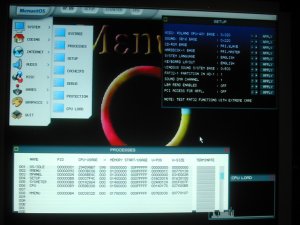 |
Menuet 0.82
System setup e services manager |
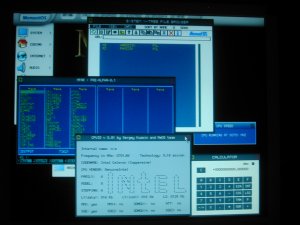 |
Menuet 0.82
Some apps |
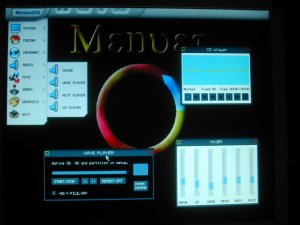 |
Menuet 0.82
Audio manager |
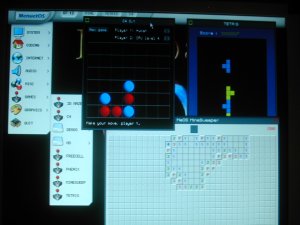 |
Menuet 0.82
Classical games |
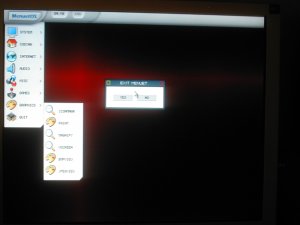 |
Menuet 0.82
Logout |
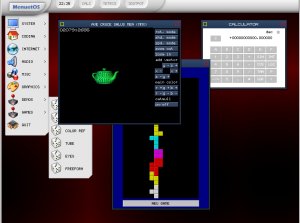 |
| VM screenshot |
JNODE 0.2.8 http://jnode.ro/

Under development, active
Curious and interesting system, created entirely with JAVA, available as an ISO image and as an image for VMware virtual machines. Still in its infancy, it has very few applications, therefore not yet usable for everyday work. The GUI (Graphical User Interface) is very intuitive and easy to use.
Screenshots:
Print Screen in Linux environment and manipulation with GIMP.
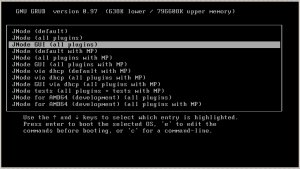 |
| The startup screen |
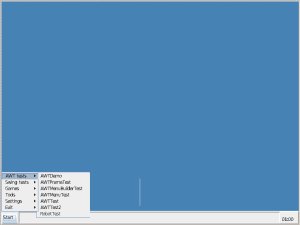 |
The desktop, simple
|
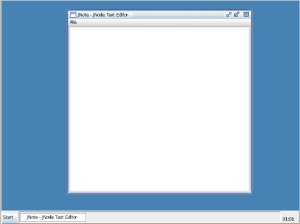 |
JNote a simple text editor
|
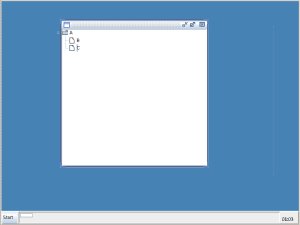 |
| Tree, files browser |
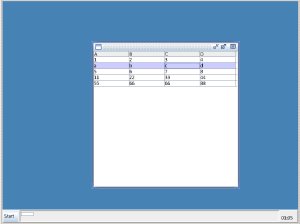 |
Table, a spreadsheet
|
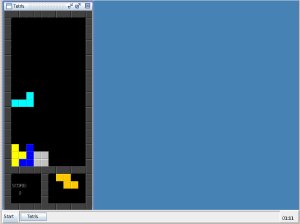 |
| Tetris, super classic |
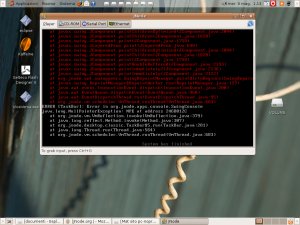 |
| VM in Linux |
KOLIBRI 0.6.5.0 https://www.kolibrios.org/it/
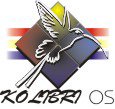
Derived from MenuetOS
Active and under development.
Very interesting elaboration of Menuet, very similar in the interface, even if that of Kolibri appears much clearer and more readable, many programs are identical, however Kolibri is equipped with many additional programs, including many games really very well done, and numerous applications of various types, including a drawing program, a text manager, a file explorer capable of accessing local hard drives, an excellent screenshot system, systems for network and general system control, resource analyzers , calendar, clocks of different types, various openGL demos and much more.
All in 1.4 MB, a floppy!!!
The system is also equipped with a simple but functional shell with some integrated commands derived from UNIX.
Compared to Menuet, from which it derives, this system is much more advanced and complete. It remains impressive how all this can fit on a floppy!!!
Screenshots:
Performed in real car. Capture via provided internal tool, mount a Win98 disk via internal tool, recover with Samba and manipulate with GIMP on Linux.
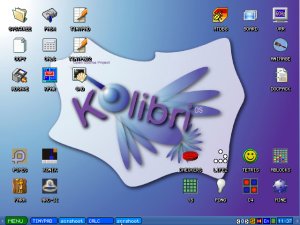 |
| The Desktop and some apps |
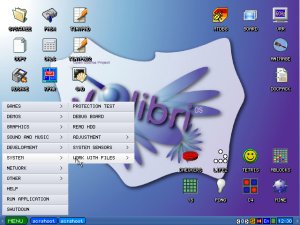 |
The start menu
|
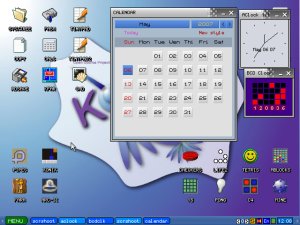 |
| Calendar and clock |
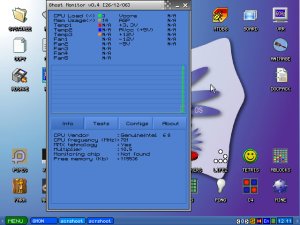 |
| Memory and CPU usage |
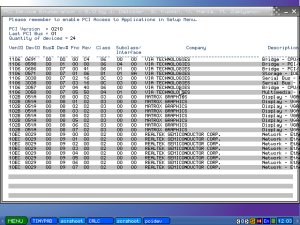 |
| PCI devices map |
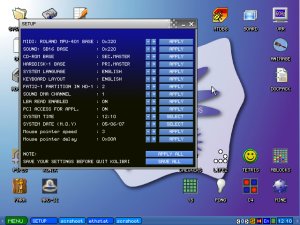 |
| Control panel |
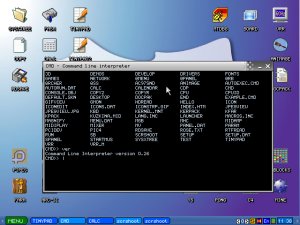 |
Command prompt
|
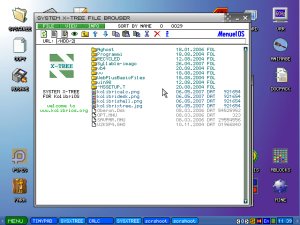 |
| File browser |
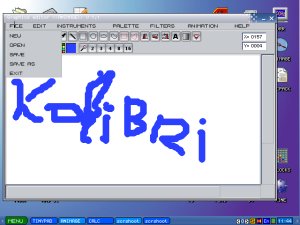 |
| Drowing app |
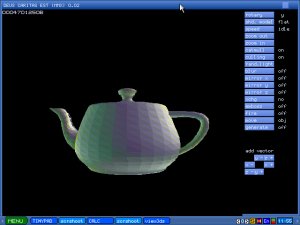 |
| 3D Rendering |
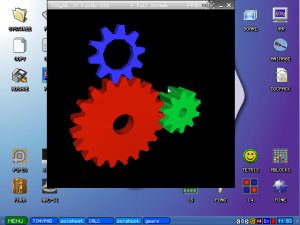 |
| Another 3D rendering |
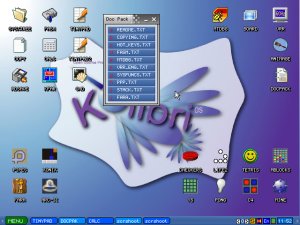 |
Documentation and help
|
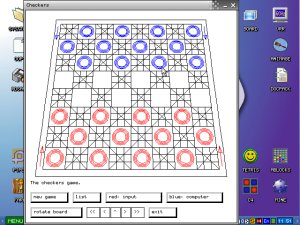 |
A kind of chess
|
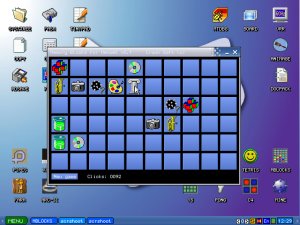 |
| Memory game |
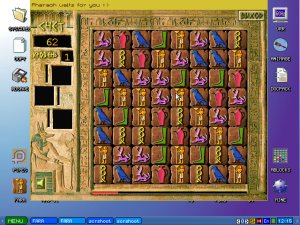 |
| Pharaon, interesting game... |
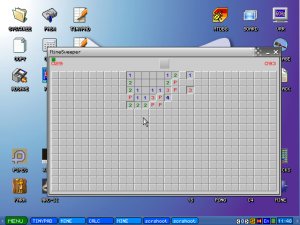 |
| Mines classic |
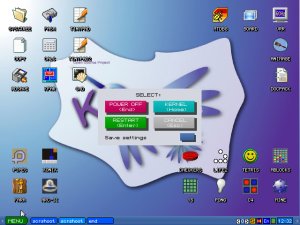 |
Logout splash
|
SYLLABLE 0.6.7 https://syllable.metaproject.frl/

Active in an advanced stage of development.
Available as an installation and as a Live CD.
Derived from ATHEOS, it has followed a different path in terms of approaching non-technical users, with the result of becoming an interesting operating system that is relatively easy to use. There are several software archives available written for SYLLABLE. Intuitive and very simple, it is natural to use, the basic version is equipped with many programs such as text editors, a mail manager, a browser, systems for the maintenance and management of disks and partitions (it is possible to mount the hard disks of the machine, even with the Live CD version!!!), it has dozens of different fonts and various desktop backgrounds, it gives the possibility to change the appearance of the windows instantly.
The screen resolution allows a lot of configuration flexibility. all in 35MB!!!
Recognizes the typical UNIX commands, excellent ability to recognize USB peripherals, overall a very interesting and powerful program, at an already very mature and complete level.
Screenshots:
Performed in real car. Screen shot via camera. A screencapture tool is missing.
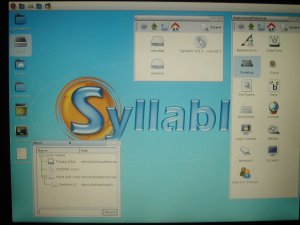 |
| The Desktop of a live CD |
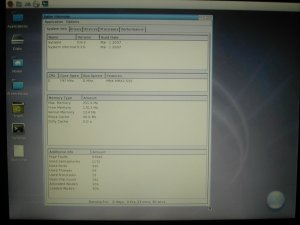 |
| System Info |
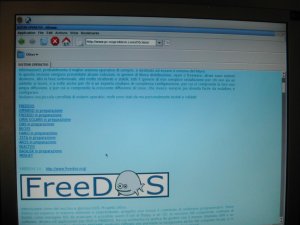 |
| ABrowse on this page |
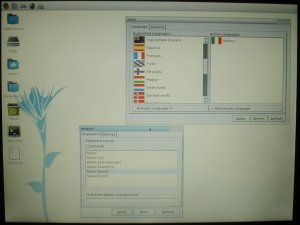 |
Keyboard and languages
management |
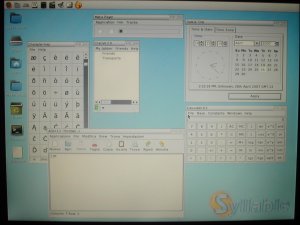 |
| Some apps |
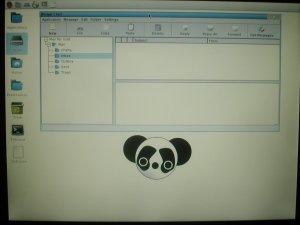 |
Whisper a mail client
|
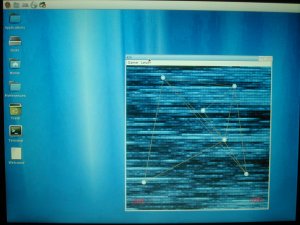 |
| Icni an interesting game |
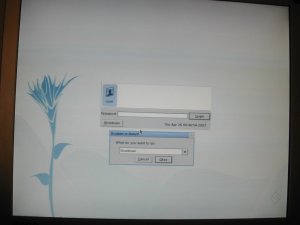 |
| Logout |
OBERON 2.5 http://www.projectoberon.com/

Active and slowly developing.
Curious operating system developed in Switzerland, the name indicates both the operating system and a programming language. Singular for the interface adopted, decidedly very unusual, it is a series of menu-windows placed on the right of the screen, with the possibility of scrolling only vertically, each menu has the basic commands in the upper part. Launched applications appear in the center-left area. There are no icons, applications are generally launched by clicking on a sort of textual hyperlink. Basically manages 4 virtual desktops. There is however the possibility of using a more orthodox interface with a desktop and windows. From the site it is possible to download various material, including an installation version and one that works as a Windows application. Interesting and fast, even quite rich in applications, but the original interface makes it quite complex to approach.
Screenshots: (in the images you can see the W98 application bar that hosts the program)
Print Screen under Win98, saving to FAT32 disk, recovering and manipulating with GIMP under Linux.
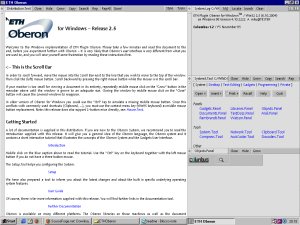 |
| A standard window |
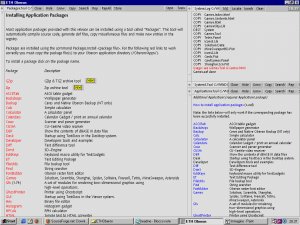 |
Application manager
|
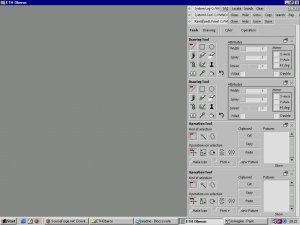 |
| Drowing app |
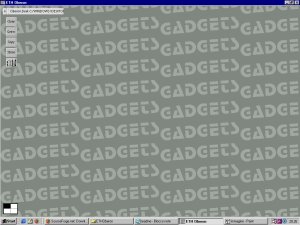 |
A desktop classical with
4 virtual desktop
|
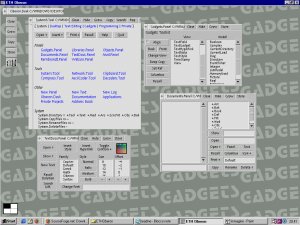 |
Some app, from the blue list
is possible open other apps |
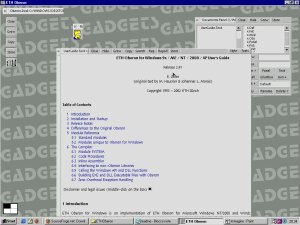 |
| User guide |
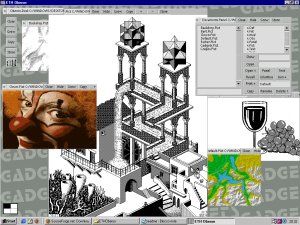 |
| Some pictures in window |
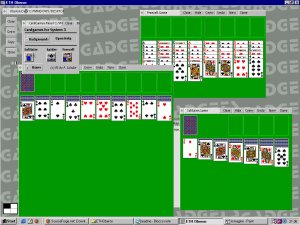 |
Card games
|
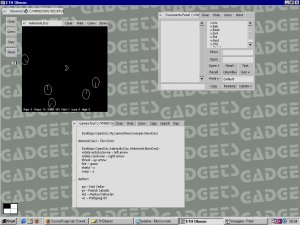 |
| Asteroids... the mith |







































































































































